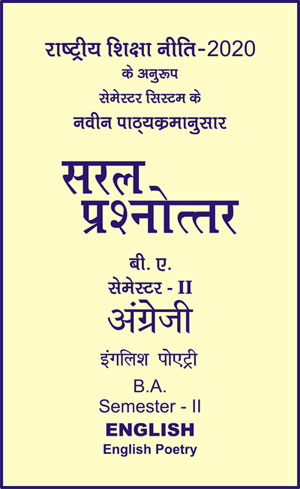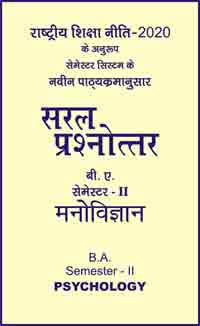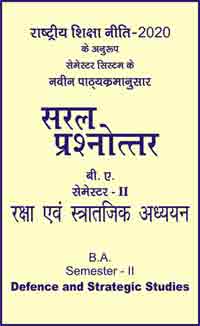|
बी ए - एम ए >> बीए सेमेस्टर-2 - अंग्रेजी - इंगलिश पोएट्री बीए सेमेस्टर-2 - अंग्रेजी - इंगलिश पोएट्रीसरल प्रश्नोत्तर समूह
|
5 पाठक हैं |
|||||||
बीए सेमेस्टर-2 - अंग्रेजी - इंगलिश पोएट्री
Chapter - 2
Poetic Device
Introduction of The Chapter
Poetic Devices: Poetic devices can be simply referred to as a form of literary devices which are used in poetry. They are used as different elements in a poem just like above in verbal, visual, structural, rhythmic, metrical, grammatical elements, and so on. These poetic devices are tools used by poets to enhanced the meaning of a poem, make it rhythmic pleasing or intensify the core emotion, mood or feeling represented in the poem.
Different Types of Poetic Devices / Structure of Poetic Devices
Poetic devices can be of three different types depending on the kind of words that are being used. Each of these poetic devices can be used for different purposes to bring out the best in a poem. The three different types of poetic devices are as follows:
• Poetic Devices based on the sound of words: Such poetic devices depend completely upon the sound of the words that are being used. Some examples of this type of poetic device are alliteration, assonance, consonance and cacophony, among others.
• Poetic Devices based on the meaning of the words: Such poetic devices completely depend upon the meanings of the words which are being used by the poet in the poem. Some examples of this kind of poetic device are allegory, allusion, irony and metaphor among others.
• Poetic devices based on the arrangements of the words : Such poetic devices are related more to the structure of the poem rather than the tone or the style. They completely depends upon the arrangement pattern of the words used by the poet in the poem. Examples of these kinds of devices are verses and rhyme schemes.
Tone: The tone of a piece of writing is its general character or attitude, which might be cheerful or depressive, sarcastic or sincere, comical or mournful, praising or critical, and so on. For instance an editorial in a newspaper that described its subject as "not even having the guts to do the job himself," has a tone that is both informal and critical.
Theme: A theme is a universal idea, lesson or message explored throughout a work of literature. One day characteristic of literary themes is their universality, which is to say that themes are ideas that not only apply to the specific characters and events of a book or play, but also express broader truths about human experience that readers can apply to their own lives. For instance, John Steinbeck's The Grapes of Wrath (about a family of tenant farmers who are displaced from their land in Oklahoma) is a book whose themes might be said to include the inhumanity of capitalism, as well as the vitality and necessity of family and friendship.
Rhythm: Rhythm is the beat and pace of a poem and is created by the pattern of stressed and unstressed syllables. It helps in strengthening the meaning and ideas of the poem. It lies between a certain range of regularity, of specific language features of sound. It is readily discriminated by the ear and the mind, having as it works on a physiological basis. It directly effects the temporal structure of the poem. Rhythm is important for the highly organized sense of poetry.
Rhyme Scheme: A rhyme scheme is the pattern according to which end rhymes (rhymes located at the end of lines) are repeated in works poetry. Rhyme schemes are described using letters of the alphabet, such that all the lines in a poem that rhyme with each other are assigned a letter, beginning with "A". For example, a four-line poem in which the first line rhymes with. the third line, and the second line rhymes with the fourth line has the rhyme scheme ABAB, as in the poem "Roses are the red/Violets are blue./Shakespeare is dead?/I had no idea."
Stressed and Unstressed Syllables : A stressed syllable is the part of a word that you say with greater emphasis than the other syllables. Alternatively, an unstressed syllable is a part of a word that you say with less emphasis than the stressed syllable(s). However, you don't emphasize or deemphasize syllables using volume; instead, you use pitch.
Meter : Meter is a regular pattern of stressed and unstressed syllables than defines the rhythm of some poetry. These stress patterns are defined in groupings, called feet, of two or three syllables. A pattern of unstressed! stressed, for instance, is a foot called an iamb. The type and number of repeating feet in each line of poetry define that lines meter. For example, iambic pentameter is a type of meter that contains five iambs per line (thus the prefix "penta", which means five).
Figure of Speech: A figure of speech is a literary device in which language is used in an unusual-or "figured"-way in order to produce a stylistic effect. Figures of speech can be broken into two main groups: Figures of speech that play with the ordinary meaning of words (such as metaphor, simile and hyperbole) and figures of speech that play with the ordinary arrangement or pattern in which words are written (such as alliteration, ellipsis, and antithesis).
Irony: Irony is a literary device or event in which how things seem to be is in fact very different from how they actually are. If this seems like a loose definition, don't worry-it is. Irony is a broad term that encompasses three different types of irony, each with their own specific definition: verbal irony, dramatic irony and situational irony. Most of the time when people use the word irony, they're actually referring to one of these specific types of irony.
Inversion: Inversion is the reversal of words in a phrase or sentence. There are several different ways to accomplish this. One might but the adjective after the noun, the verb before the subject, or the noun before the preposition. Sometimes, inversion happens naturally. For example, when someone uses a sentence like "What a terrible turn of events."
Negative Capability: Negative capability is a phrases coined by John Keats to describe the poet's ability to live with uncertainty and mystery.
Juxtaposition: Juxtaposition occurs when an author places two things side by side as a way of highlighting their differences Ideas, images, characters and actions are all things that can be juxtaposed with one another.
For example, it's a common plat device in fairy tales such as Cinderella to juxtapose the good-natured main character with a cruel step-sibling. The differences between the characters, as well as their close relation to one another, serve to highlight the main character's good qualities.
How do Poetic Devices Work?
They are literary devices such as grammar, rhythm structure that aid a poet in creating poetry. Poetic devices may enhance the timing and rhythm of the poem, the meaning of the words or the emotions felt by those reading it.
While finding out what a poetic device is answers a good, pure and curious question, it's not as useful as you may think. The important thing from a craft or appreciation perspective isn't so much what a poetic device is but what it does.
Poetic devices form patterns and these patterns do various things describe, persuade, inform, inspire, illustrate, elevate, sing and inscribe words into memory. You can break things down into general categorical functions. Each device you'll find or use in a poem probably serves atleast one of these roles:
• Roric: Persuading someone of feel or do something.
• Prosodic: Creating a sound or rhythm
• Semantic: Establishing a meaning.
• Aesthetic: Creating beauty.
Tone
The tone of a piece of writing is its general character or attitude, which might be cheerful or depressive, sarcastic or sincere, comical or mournful, praising or critical and so on. For instance, an editorials in a newspaper that described its subjects as "not even having the guts to do the job himself," has a tone that is both informal and critical.
Some additional key details about tone:
• All pieces of writing, even letters and official documents, have a tone. A neutral, official tone is still a tone.
The tone of a piece of writing may change over the course of a text to produce different effects.
• Tone and mood are not the same. Tone has to do with the attitude of the author or the person speaking, whereas mood is how the work makes the reader feel.
The author's intentions, emotions and personal ideas about the theme or subject matter often reveal themselves in the piece's tone."
Theme
A theme is a universal idea, lesson or message explored throughout a work of literature. One key characteristic of literary themes is their universality, which is to say that themes are ideas that not only apply to the >pecific characters and events of a book or play, but also express broader truths about human experience that readers can apply to their own lives. For nstance, John Steinbeck's The Grapes of wrath (bout of family of tenant farmers who are displaced from their land in Oklahama) is a book whose chemes might he said to include the inhumanity of capitalism, as well as the vitality and necessity of family and friendship.
Some Additional Key details about theme: All works of literature have themes. The same work can have multiple themes, and many different works explore the same or similar themes. Themes are sometimes divided into thematic concepts and thematic statements. A work's thematic concept is the broader topic it touches upon (love, forgiveness pain, etc.) while its thematic statement is what the work says about that topic. For example, the thematic concept of a 'romance novel might be love and depending on what happens in the story, its thematic statement might be that "Love is blind" or that "You can't buy love."
Themes are almost never stated explicitly. Often times you can identify a work's themes by looking for a repeating symbol, motif or phrase that appears again and again throughout a story, since it often signals a recurring concept or idea.
Rhythm
Rhythm is the use of stressed and unstressed syllables, which creates what you experience as a pattern of beats in the sound of the words. The word rhythm comes from the Greek wood rhythmos, which can be translated as "measured motion".
The best poems roll over our tongues with a tested and proven pathway, and that's clearly not by accident: the writer intentionally crafted each line, designed to lure our souls into its magic. Experts in literature highly recommend young children by exposed to nursery rhymes and poetry from an early age because instills an appreciation for language that they will carry into adulthood. By if you have not had that privilage, it's definitely not too late to learn how to write with rhythm.
First, you should learn the most common rhythms utilized in English literature. Since rhythm uses a pattern of stressed (and unstressed (x) syllables, we must understand how each word plays a part in a line.
When we speak, certain syllables are stressed, while others are unstressed. For example, when we say the word father, we stress the first syllable, Father.
The key is being able to string the words together so that they form a pattern of stressed and unstressed syllables, repeated line after line. Each pair of stressed and unstressed syllables is called a foot.
Examples of Common Rhythms Used in English Literature: The following are the most common rhythms found in English poetry. We will show you how each rhythm sounds using the symbol "X" the indicate an unstressed syllable, and "/" to indicate a stressed syllable.
Rhyme Scheme
A rhyme scheme is the pattern according to which end rhymes (rhymes located at the end of lines) are repeated in works poetry. Rhyme scheme are described using letters of the alphabet, such that all the lines in a poem that rhyme with each other are assigned a letter, beginning with "A". For example, a four line poem in which the first line rhymes with the third line and the second line rhymes with the fourth line has the rhyme scheme ABAB, as in the poem "Roses are red/Violets are blue/ Shakespeare is dead?/I had no clue."
Some additional key details about rhyme scheme :
• Rhyme scheme represent stanza breaks using space. So a poem made up of two rhyming couplets (two line stanzas) would be said to have a rhyme scheme of AA BB.
• There are different conventions for writing out rhyme schemes. Some people use lowercase letters (abab). Some use uppercase (ABAB) and some even throw in italics or hyphens (a-b-a-b). This formatting aspect of rhyme schemes is not every scientific.
• Rhyme are used in all types of poetry, but they don't always occur in regular patterns or at the ends of lines-so not all poems that use rhyme. necessarily have rhyme schemes. Rhyme schemes are only used to describe poem that use end rhyme (that is, rhymes at the ends of lines).
Meter
Meter is a regular pattern of stressed and unstressed syllables that defines the rhythm of some poetry. These stress patterns are defined in groupings, called feet of two or three syllables. A pattern of unstressed- stressed, for instance, is a foot called an iamb. The type and number of repeating feet in each line of poetry define that line's meter. For example, iambic pentameter is a type of meter that contains five iambs per line (thus the prefix "penta" which means five).
Some additional key details about meter :
• The study and use of meter in poetry is known as "prosody".
• A poem can use a single meter throughout or it can have different meters in different places. Meter can be analyzed one the level of a whole poem, a stanza, a line, or even a single foot.
• The way meter is measured depends on the language in which a poem is written. Meter in English verse is accentual, meaning it is derived from the emphasis placed on certain syllables.
Stressed and Unstressed Syllables
A stressed syllable is the part of a word that you say with greater emphasis than the other syllables. Alternatively, an unstressed syllable is a part of a word that you say with less emphasis than the stressed syllable(s).
Though emphasis (stress) and pitch (intonation) are different, they are connected. How we stress certain syllables or words changes. the pitch. Similarly, the pitch we use in certain contexts can also affect which syllables get stressed.
Figure of Speech
A figure of speech is a literary device in which language is used in an unusual-or "figured"-way in order to produce a stylistic effect. Figures of speech can be broken into two main groups: figures of speech can be broken into two main groups: figures of speech that play with the ordinary meaning of words (such as metaphor, simile, and hyperbole), and figures of speech that play with the ordinary arrangement or pattern in which words are written (such as alliteration, ellipsis and antithesis).
Some additional key details about figures of speech:
• The ancient Greek and Romars exhaustively listed, defined and categorized figures of speech in order to better understand how to effectively use language. The names of most figures of speech derive from the original Greek or Latin.
• Figures of speech that play with the literal meaning of words are called tropes, while figures of speech that play with the order or pattern of words are called schemes.
• Figures of speech can take many forms. A figure of speech can involve a single words, a phrase, an omission of a word or phrase, a repetition of words or sounds, or specific sentence structures.
Irony
Irony is a literary device or event in which how things seem to be is in fact very different from how they actually are. If this seems like a loose definition, don't worry-it it. Irony is a bread term that encompasses three different types of irony, each with their own specific definition: verbal irony, dramatic irony, and situational irony. Most of the time when people use of word irony, they're actually referring to one of these specific types of irony.
Some additional key details about irony:
• The term "irony" comes from the ancient Greek comic character called the "eiron", who pretends ignorance in order to deceive an opponent.
• Irony overlaps with, but is not identical to sarcasm and satire.
• In the last twenty years or so, the term "ironic" has become popular to describe an attitude of detachment or subversive human, like that of someone who wears a Christmas sweater as a joke. This more recent meaning of ironic is not entirely consistent with the original meaning of irony (a fact which itself night be described as being somewhat ironic).
Inversion
Inversion is the reversal of words in a phrase or sentence. There are several different ways to accomplish this. One might put the adjective after the noun, the verb before the subject, or the noun before the preposition. Sometimes, inversion happens naturally. For example, when someone uses a sentence like "what a terrible turns of events"
Sometimes writers use inversion in meter. This is a far less common use of the definition, but it still applies. For example, one might say that a line of meter is inverted if it starts out in iambic pentameter (one unstressed and one stressed beat) and then changes to trochic pentameter (one stressed and one unstressed beat). This can also be known as substitution.
Inversion can be used in short stories, poems, novels, prose, poetry, plays and more. It also appears in everyday speech. Often, people will change around the traditional pattern of a sentence in order to make their words sound a certain way. For example, when speaking about another person's decision, someone might say, "A surprising decision you made there" rather than "You made a surprising decision there." The first sounds more interesting and can make the speaker sound more distinguished if used in the right context.
One of the most famous examples comes from Star Wars and the character Yoda who uses inversican every time he speaks. For example, the famous line "Patience you must have, my young padawan" rather than "You must have Patience, my young padawan". The writers chose to give Yoda's speech this features in order to emphasize his wisdom and his alien nature in comparison to Luke's own very human-seeming characteristics.
Negative Capability
The concept of negative capability pertains to the ability to live with-in the penetralium of mystery or deal with unanswered questions. Not every event-especially in fiction-needs to (or will) have a direct, statisfying. explanation. Negative capability embraces this half-knowledge, creating a wilful suspension of disbelief in service of the openness and curiosity a geared toward a greater, more imaginative story. Exploring the temporary beauty of a passing moment is more important than figuring out why or how that moment exists.
Juxtaposition
Juxtaposition occurs when an author places two things side by side as a way of highlighting their differences. Ideas, images, characters, and actions are all things that can be juxtaposed with one another. For example, it's common plot device in fairy tales such as Cinderella to juxtaposed the good natured main character with a cruel step-sibling. The differences between the characters, as well as their close relation to one another, serve to highlight the main character's good qualities. Some additional key details about juxtaposition:
The verb form of juxtaposition in juxtapose, as in "the author juxtaposition the protagonist's dirty, ragged clothes with the spotless interior of the wealthy villian's mansion."
The word juxtaposition comes from the Latinjurta meaning "next" and the French poses meaning "tophee." This combination suggests juxtaposition's meaning:
"to place next to”.
Juxtaposition and Related Terms: Because juxtaposition is such a broad concept, covering the contrast created between all sorts of different things when placed in close proximity, there are a number of terms that overlap with it or fall under its broader umbrella. Three of the most common of these terms are foil, antithesis and oxymoron.
Juxtaposition and Foils: A foil is one specific form of juxtaposition having to do with contrasts between characters. When a writer creates two characters that possess opposite characteristics, it's often with the intension of highlighting some specific about one or both of the characters by juxtapose their qualities.
Such characters are foils of one another. The tortoise and the hare, from the famous folk take, are examples of foils. "Juxtaposition" describes the writer's action of placing these two characters next to one another for the purposes of comparing them, while foil is a word that describes the characters themselves (the hare is a foil to the tortoise, and vice-versa).
|
|||||
- Chapter - 1 Forms of Poetry & Stanza Forms
- Objective Type Questions
- Answers
- Chapter - 2 Poetic Device
- Objective Type Questions
- Answers
- Chapter - 3 "Let Me Not to the Marriage of True Minds" (Sonnet No. 116)
- Objective Type Questions
- Answers
- Chapter - 4 "On His Blindness"
- Objective Type Questions
- Answers
- Chapter - 5 "Present in Absence"
- Objective Type Questions
- Answers
- Chapter - 6 "Essay on Man”
- Objective Type Questions
- Answers
- Chapter - 7 "Elegy Written in a Country Churchyard”
- Objective Type Questions
- Answers
- Chapter - 8 "The World is Too Much with Us"
- Objective Type Questions
- Answers
- Chapter - 9 "Ode on a Grecian Urn"
- Objective Type Questions
- Answers
- Chapter - 10 "Break, Break, Break"
- Objective Type Questions
- Answers
- Chapter - 11 "How Do I Love Thee?"
- Objective Type Questions
- Answers
- Chapter - 12 "Dover Beach"
- Objective Type Questions
- Answers
- Chapter - 13 "My Last Duchess'
- Objective Type Questions
- Answers
- Chapter - 14 "The Love Song of J. Alfred Prufrock"
- Objective Type Questions
- Answers
- Chapter - 15 "The Lake Isle of Innisfree"
- Objective Type Questions
- Answers
- Chapter - 16 "Church Going"
- Objective Type Questions
- Answers
- Chapter - 17 Rhetoric and Prosody - Practical Criticism
- Objective Type Questions
- Answers














